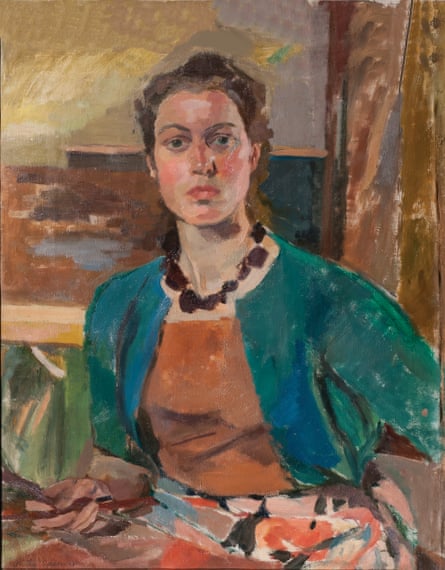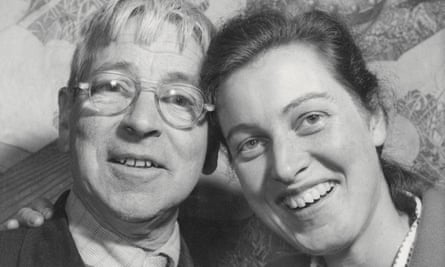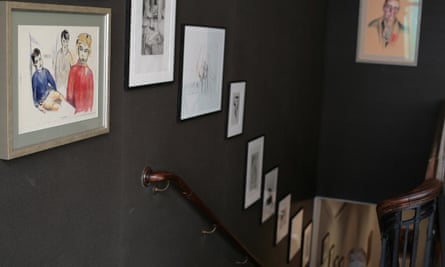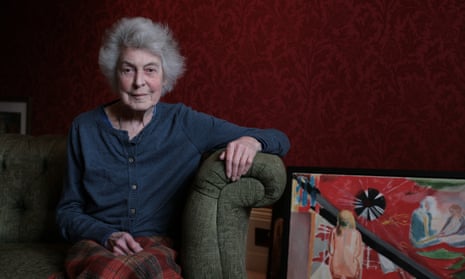Unity Spencer, who has died aged 87, was perhaps best known for being the daughter of the artist Stanley Spencer, but she was also a talented painter in her own right, a skilful realist with a powerful imaginative vision. Two of her best and most memorable works, which reveal her father’s influence, are a striking self-portrait from 1954, and a 1957 portrait of Stanley himself.
She had three solo shows of her paintings in London, and contributed to many mixed exhibitions, from the London Group to the Royal Academy shows. The first of her one-person shows was at Lauderdale House in Highgate, in 1993, the second at the Boundary Gallery in St John’s Wood in 2001, both in north London, but it was the third that really established her reputation. In 2015, the Fine Art Society in Bond Street mounted the first West End exhibition of her work, to coincide with the publication of her autobiography, Lucky to Be an Artist. Fifty of her paintings from all periods were shown along with her etchings, accompanied by a group of pictures by her family: works by her parents, her uncles Gilbert Spencer and Richard Carline, and by her grandfather George Carline.

This show came at the suggestion of a friend, the painter David Inshaw. He recalled visiting her house in Clapham (where, according to her son, she had inscribed “Daring, Joy and Love” on her bedroom wall), expecting to find it hung with paintings by herself and her parents. But the walls were oddly bare, with not even her own work in sight.
The public has always been more interested in the Spencer/Carline family’s eccentric lifestyle than in the art produced and Unity spent a substantial part of her life explaining if not defending her parents. This was not always an easy task, as her unusual upbringing had left her prey to depression, and her own life was a troubled one.
She recorded its ups and downs in her memoir and wrote matter-of-factly: “Children of geniuses tend to have a rather hard time of it.” She did however sum up Stanley thus: “My father needed to be alone a great deal, not because he had a ‘monkish’ temperament but simply that he had to go into himself and rummage around and walk about inside himself; this was his source of strength and conviction.” This is a precise description of a very particular artistic identity.
Born in Hampstead, north London, Unity was the second daughter of Hilda (nee Carline) and Stanley. Of Unity, Stanley commented: “The baby looks awful but will improve with time”; in fact, she grew into a beautiful woman. The Carlines were an artistic dynasty of some repute, and both Unity’s parents were painters. This made for a lively and unusual existence. For instance, as a small baby, Unity was wrapped in a shawl and laid on a chair in the chapel at Burghclere, in Hampshire, while her father continued to paint the murals that are one of his finest achievements.

By 1932 the family had settled in Stanley’s home village of Cookham, in Berkshire. Both parents were difficult, Stanley legendarily so, and after meeting and becoming infatuated with a local artist, Patricia Preece, he soon decided he and Hilda could no longer live together. When Unity was four, her mother took her to live with her Grannie Carline in Hampstead, where she went to Miss Osborn Smith’s school. Her older sister, Shirin, had already been sent away to live with a distant relative, a Mrs Harter, when Unity was born. “So from then until I was about 19 there were big gaps when we saw little or nothing of D [her father].” And when she did see him, her loyalties were divided, in even the most basic of ways. “M [her mother] tried to make me tidy, D liked me to be untidy.” In 1937, Hilda and Stanley divorced, and Stanley married Patricia. Hilda could not take the strain, and two years later Unity was sent to Epsom to live with Shirin and Mrs Harter.
This was not a happy time and Unity felt rejected. It seemed that neither of her parents would take responsibility for her, and thus she began to suffer from the deep-seated anxiety and low self-esteem that were to plague her for many years. Although she maintained that both her parents were loving people, neither was especially demonstrative, except when it came to art.
Hilda gave Unity her first oil painting lesson. Stanley talked to her about the design and rhythm of a painting and once told her that design was the image of the soul. Unity had the chance to get to know her father better in the 1940s when his relationship with Patricia was finally over (although she would never grant him a divorce) and began to visit his daughters regularly. Unity was by now at Badminton school, which had moved from Bristol to Devon during wartime (1941-48). “I didn’t feel resentful – rightly or wrongly,” Unity said. “I felt that he was honest about what had happened … that he had taken himself to task over it. And that meant a lot to me.”
But time was running out for Hilda, whose behaviour became increasingly irrational. Not only did Unity have to face the challenge of understanding her mother’s mental illness, but Hilda, being a Christian Scientist, would never accept that she was ill, which made her terminal cancer even more difficult to cope with.
Unity was determined to be a professional artist and had just started as a student at the Slade (after two years at Wimbledon Art School) when her mother died in 1950. In 1956 she suffered her first bout of depression, which lasted for more than a year. However, she kept working during these dark times, earning her living teaching art, first at The Downs in Herefordshire, then at Bedgebury Park school in Kent (1956-61). Stanley died in 1959, and Unity’s feelings of loneliness and her need to be protected and loved became ever more pronounced.
The following year she joined the International Voluntary Service and spent two summers working in Germany, digging trenches with pickaxes and helping to build homes for Hungarian refugees. In 1961 she met Leslie Lambert, who was to be the father of her son and who, she wrote, “was to blight the next decade of my life”. Almost 20 years older than Unity, he was a communist, former trade union official and a member of the Salvation Army, but also moody and unstable. By her account, life with him was surpassingly difficult, as he subjected her to a campaign of mental cruelty, and nagged her into getting pregnant. Their son, John, was born in 1963. The couple did not marry, and legal battles ensued over the child’s custody, which were only resolved when Leslie died after a heart attack in 1971. Unity herself nearly collapsed, and she received counselling and therapy to help her through the subsequent 10 years. She was also drawn to the Quakers for comfort.

It was not until 1975 that she returned to teaching, first at a Rudolf Steiner school in London and later at Long Close school in Slough (1980-88). For a year in between she taught art to hairdressers at Langley College of Further Education in Slough (1977).
Dance and music were immensely important to her, and if she had not been an artist, she once said, then she would have wanted to be a professional dancer. One of her early paintings reveals her varied interests, the subject being a backstage view of an opera: “I’m in the foreground because I was living in two worlds. I was a student at the Slade and a member of the chorus of The Merry Wives of Windsor.”
She poured herself into her art, and painted orchestral rehearsals and concerts, travel by bus and tube, all kinds of domestic scenes and landscapes. Her painting life was interrupted by spells of profound depression (until they miraculously ceased in 2001), but these emotional upsets gave her a wider spectrum of subject to put into her art. She developed a form of surrealist dream painting, and her more inventive work often makes direct reference to Edvard Munch’s symbolic treatment of psychological themes.
Although art for her was an important form of therapy, she was very clear about the role of art in healing people: she knew it did not automatically make them good artists and she had no illusions about the difference between amateur and professional. She remarked late in life: “People say to me, ‘Oh Unity, it must be so relaxing to be an artist.’ Absolute rubbish. Art is hard work. I am lucky to be an artist.”
Unity is survived by her son, John, and her sister, Shirin.

Comments (…)
Sign in or create your Guardian account to join the discussion